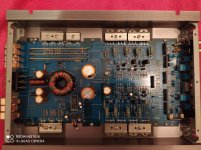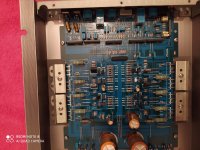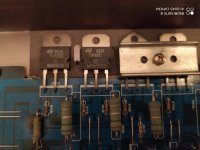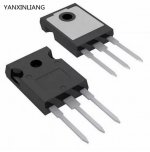If you have followed this thread, you should have noted that this is about the power amplifier stage. The power amplifier stage of the amp is going to sound precisely the same, no matter the amp if it's a typical solid state amp using global feedback, that's in good working order. The preamp stage (crossovers, EQs, other filters...) can and will make a difference.
Not the power amplifier stage of solid state amps with global feedback.
Tube amps... a completely different animal. The impedance variations across the spectrum can be audible. Sometimes an amp can sound awful with one pair of speakers and wonderful with another pair. Add to that, the tubes themselves can make a difference in the sound. That's not so with a solid state amp.
Tube amps... a completely different animal. The impedance variations across the spectrum can be audible. Sometimes an amp can sound awful with one pair of speakers and wonderful with another pair. Add to that, the tubes themselves can make a difference in the sound. That's not so with a solid state amp.
Well, it made a difference. ��
And going by what the people who compete say and do, it suggests the same. They go so far as to use discontinued amplifiers.
There might be different designs out there that's like you say, I'm not that in to it.
And going by what the people who compete say and do, it suggests the same. They go so far as to use discontinued amplifiers.
There might be different designs out there that's like you say, I'm not that in to it.
Are they using the power amplifier alone and bypassing the preamp circuit?
People who know nothing say a lot of things with no proof of anything.
Do you know what global feedback is/does?
The OP for this thread is confused enough. It would be good to eliminate any more confusion. Before long, he'll start replacing all of the caps to make his amp sound better... just like all of the other people online who have replaced perfectly good caps, and heard a huge difference in the sound.
There was a challenge that was set up in the 90's (?) that would pay $10k for anyone who could tell the difference between two different amplifiers if they were gain matched. As far as I know, no one ever won it.
The audio world is as filled with bad information as politics is filled with corruption.
People who know nothing say a lot of things with no proof of anything.
Do you know what global feedback is/does?
The OP for this thread is confused enough. It would be good to eliminate any more confusion. Before long, he'll start replacing all of the caps to make his amp sound better... just like all of the other people online who have replaced perfectly good caps, and heard a huge difference in the sound.
There was a challenge that was set up in the 90's (?) that would pay $10k for anyone who could tell the difference between two different amplifiers if they were gain matched. As far as I know, no one ever won it.
The audio world is as filled with bad information as politics is filled with corruption.
I have no real knowledge.
The people who I have watched does.
I don't doubt my experience, it was night and day difference.
I will leve the thread so you can solve the problems. ��
The people who I have watched does.
I don't doubt my experience, it was night and day difference.
I will leve the thread so you can solve the problems. ��
Hi ! thanks again for the very valuable advice. I do not need much power in my current situation. I will look for the brands you mentionref. post 98 ...
😱... People who know nothing say a lot of things with no proof of anything....
 You are very right
You are very rightJust one last question about how the power voltage is generated from the 12VDC
Do these amps use a DC-DC converter ? i know that is off-topic but i think that this circuit takes the 12VDC and elevate it to produce a dual voltage for the amp ... is this correct ?
Thanks a lot again.
I used to use an 8 track car audio system in my garage.
Ran off a 12 volt mains power pack.
Sounded great. I had some really good 8 track tapes.
Ran off a 12 volt mains power pack.
Sounded great. I had some really good 8 track tapes.
Most anything that's going to produce more than about 20W into 4 ohms is going to use a switching power supply (a type of DC-DC converter) to boost the voltage. That's why they have a transformer.
Thanks again. Yes now i understand P=V^2/R so with 12VDC and R=4 ohm the power is 12^2/4= 36 W/channelref. post 110
This of dc-dc converter is a very interesting topic in general
That's peake power. You have to multiply the supply voltage by 0.71 to get RMS power.
12*0.71=8.52
8.52^2=72.5
72.5/4=18 (half of peak power)
Switching power supply design, basics. You'll need a browser that will allow you to see flash graphics.
Basic Switching Power Supply Design Tutorial
12*0.71=8.52
8.52^2=72.5
72.5/4=18 (half of peak power)
Switching power supply design, basics. You'll need a browser that will allow you to see flash graphics.
Basic Switching Power Supply Design Tutorial
Hi ! thanks a lot again. I will read the link hoping to understand something in a very interesting fieldref. post 112
In the meantime i have opened the amp
From your words i understand that is better not to touch anything
There is just one point that i do not understand Why to parallel two pairs of 80W output bjts per channel instead of using just one pair of 150W bjts per channel ? or even 200W pairs... i know they exist
The output bjts used are obsolete. The two power supply caps are just 3300uF
Ok ... if you say that is better to leave it as it is i will do.
I like very much the case built ... it works as a whole heatsink Very smart
I could in the future look for a fused amp and use the chassis for some diy ab design and mains transformer out.
Thanks again.
Attachments
I think those tip33/35s are 125 w devices, not 80.
The size of the rails caps in smps power supplies are generally smaller ( though low esr and high ripple current) Compared to linear power supply caps as they “refilled” at a much higher frequency, 10s of KHz vs 50/60Hz.
The size of the rails caps in smps power supplies are generally smaller ( though low esr and high ripple current) Compared to linear power supply caps as they “refilled” at a much higher frequency, 10s of KHz vs 50/60Hz.
The 33 is an 80w transistor.
The TIP35C is still available.
I would guess that this amp has been repaired and someone mixed the transistors. What are the rest of the transistors? Don't lift them from the silpads.
They use what's the best bang for the buck. Using multiple transistors in parallel give better power/heat dissipation into the heatsink.
The secondary power supply has two rail caps. The primary has 3 capacitors.
Post #114 was right about the rail caps. To use mains power, you have to use much larger caps (and remember that you have other circuits that may need modification to work from a mains supply.
When do you plan on actually connecting a signal source, the power supply, and the speakers?
The TIP35C is still available.
I would guess that this amp has been repaired and someone mixed the transistors. What are the rest of the transistors? Don't lift them from the silpads.
They use what's the best bang for the buck. Using multiple transistors in parallel give better power/heat dissipation into the heatsink.
The secondary power supply has two rail caps. The primary has 3 capacitors.
Post #114 was right about the rail caps. To use mains power, you have to use much larger caps (and remember that you have other circuits that may need modification to work from a mains supply.
When do you plan on actually connecting a signal source, the power supply, and the speakers?
good morning in the current situation I have access to my electronics only during the weekend and often urgent things to do come up
But I must say that your very kind and very useful indications made me understand that the amp will basically sound like any other amp at least decent That are the speakers that make the difference
Despite this, to better understand the technique behind these amplifiers I would like to be redirected to some threads that speak specifically of modification / upgrade
I am perfectly aware that designers have a budget to stick to and often work wonders within that budget
I do not have the same budget limitations so I could spend some money if this will bring any kind of improvements.
But speaking for example of this particular amp I see that the output transistors are obsolete parts
https://www.st.com/resource/en/datasheet/CD00000920.pdf
TIP33C Manufacture Suggested Alternative - Cross Reference - Engineering and Component Solution Forum - TechForum │ Digi-Key
and that the new models look to have an improved heat exchange (?) and I guess that in general they have better characteristics
Those i really would like to use for instance
But even the reduction to a single more powerful pair taking into account that the transistors are never precisely matched could also be an alternative considering the low power i need.
There is an opinion around that promotes the single output pair approach.
Many great mid power amp have only a single pair at the output Many many
Last but not least, the replacement of the two power supply capacitors with others of higher quality same uF on the basis of the kind and valuable advice from member The Lord Flashheart (i thank him very much for that)
But first I really would like to find the above thread ... unfortunately I have no measuring equipment that can give me the evidence of electrical improvements
In a word ... as soon as I will be freer (i.e. retired) this will be my game ... and I will also try to equip myself to measure at least the basic parameters (noise and distortion)
As soon as I can connect it I will let you know ... but as I said above the curiosity is greatly diminished If they all sound pretty much the same ...
Thanks again and best regards, gino
But I must say that your very kind and very useful indications made me understand that the amp will basically sound like any other amp at least decent That are the speakers that make the difference
Despite this, to better understand the technique behind these amplifiers I would like to be redirected to some threads that speak specifically of modification / upgrade
I am perfectly aware that designers have a budget to stick to and often work wonders within that budget
I do not have the same budget limitations so I could spend some money if this will bring any kind of improvements.
But speaking for example of this particular amp I see that the output transistors are obsolete parts
https://www.st.com/resource/en/datasheet/CD00000920.pdf
TIP33C Manufacture Suggested Alternative - Cross Reference - Engineering and Component Solution Forum - TechForum │ Digi-Key
TIP33C 1 is can obsolete part from STMicroelectronics. In their EOL P/N TIP33CG 2 is suggested as a replacement
and that the new models look to have an improved heat exchange (?) and I guess that in general they have better characteristics
Those i really would like to use for instance
But even the reduction to a single more powerful pair taking into account that the transistors are never precisely matched could also be an alternative considering the low power i need.
There is an opinion around that promotes the single output pair approach.
Many great mid power amp have only a single pair at the output Many many
Last but not least, the replacement of the two power supply capacitors with others of higher quality same uF on the basis of the kind and valuable advice from member The Lord Flashheart (i thank him very much for that)
But first I really would like to find the above thread ... unfortunately I have no measuring equipment that can give me the evidence of electrical improvements
In a word ... as soon as I will be freer (i.e. retired) this will be my game ... and I will also try to equip myself to measure at least the basic parameters (noise and distortion)
As soon as I can connect it I will let you know ... but as I said above the curiosity is greatly diminished If they all sound pretty much the same ...
Thanks again and best regards, gino
Attachments
Last edited:
I would guess that this amp has been repaired and someone mixed the transistors. What are the rest of the transistors?
Don't lift them from the silpads.
The metal tab on the TO-218 and the TO-247 case are nearly identical. The plastic housing's shape is the biggest difference.
With the absolute minimum number of output transistors, you're limited on power.
How many manufacturers advertise that a minimum number of outputs improves the sound quality?
Measuring noise and distortion on car amps can be difficult. A slight variation in how the wires are connected or laid out can make a huge difference. Filtering (in the software) can help but can still give misleading results. If you don't use the exact same setup from one test to the next, the only thing that you'll be testing is the setup.
I will not help with any magical modifications. If there is a problem with the amp that makes it unreliable, I will make suggestions.
Don't lift them from the silpads.
The metal tab on the TO-218 and the TO-247 case are nearly identical. The plastic housing's shape is the biggest difference.
With the absolute minimum number of output transistors, you're limited on power.
How many manufacturers advertise that a minimum number of outputs improves the sound quality?
Measuring noise and distortion on car amps can be difficult. A slight variation in how the wires are connected or laid out can make a huge difference. Filtering (in the software) can help but can still give misleading results. If you don't use the exact same setup from one test to the next, the only thing that you'll be testing is the setup.
I will not help with any magical modifications. If there is a problem with the amp that makes it unreliable, I will make suggestions.
The TIP33CG is the same part. The "G" means it's lead-free. I can't imagine you'd gain anything by swapping a perfectly functional part for an identical part.
Good morning ! i promise in the weekend i will take more pics of the output transistors for sure I have already found a promising pair to replace them with a single one
TIP36C | Transistor STMicroelectronics TIP36C, TO-247, 3 Pin Singolo | RS Components
Sorry if i reply using your words 😱 but i have been warned about the way i quote
But it is true that also amps with many paralleled output devices sound also excellent For my purpose it is just a matter of simplification
I need some 6-7 clean amperes/channel out of this amp ... no more
I will be using it with high efficiency speakers.
TIP36C | Transistor STMicroelectronics TIP36C, TO-247, 3 Pin Singolo | RS Components
Sorry if i reply using your words 😱 but i have been warned about the way i quote
i understand this ... but let's say that the output devices have been repaired ... this must say something My opinion is very trivial ... in parallel devices not all the transistors work the same. With the excellent exception of multi-emitter type like Sanken that are paralleled bjts but in the same chip ... i would try those ones but the very high bandwidth could lead to oscillations ? if not they would be by far my 1st choice ... just one 200W pair for channel ... sizes allowing of coursePerry Babin - With the absolute minimum number of output transistors, you're limited on power
Gamut audio for instance ... from the start of the company they have been using only one pair of power mosfet per channel and their amps sound quite excellent from what i readPerry Babin - How many manufacturers advertise that a minimum number of outputs improves the sound quality ?
But it is true that also amps with many paralleled output devices sound also excellent For my purpose it is just a matter of simplification
I need some 6-7 clean amperes/channel out of this amp ... no more
I will be using it with high efficiency speakers.
Thanks a lot and this is very bad indeed. Very bad. I did not know that they are so sensitive to wires routing. This is a very critical point, possibly a show-stopper for my project 🙁Perry Babin - Measuring noise and distortion on car amps can be difficult. A slight variation in how the wires are connected or laid out can make a huge difference ...
Message received strong and clear. But the wires routing issue i really did not expect that ... i was not aware of it at all Very bad newsPerry Babin - I will not help with any magical modifications.
If there is a problem with the amp that makes it unreliable, I will make suggestions.
Last edited:
I've said it before but the audio industry is full of gimmicks. Most are useless.
Mismatched output transistors that are in parallel won't generally affect the sound (remember the global feedback) but it can affect the reliability when the amp is driven to its limits.
You are worried about the slightest faults in an amp. Although most people will claim that they can hear the slightest distortion and never drive their amps into clipping, I can assure you that most cannot hear the onset of clipping, especially at high volume. The onset of clipping is easy to hear with a pure tone, especially in the middle of the spectrum, but with music, it's much harder to hear. The reason that I mention this is because the most obvious type of distortion is basically inaudible when it's many times greater than the things that you seem to be looking for.
Why is testing important? (showstopper?) Do you plan on listening to the amps or to document the test results for some reason?
Why do you state that you need 'amps' instead of watts?
Mismatched output transistors that are in parallel won't generally affect the sound (remember the global feedback) but it can affect the reliability when the amp is driven to its limits.
You are worried about the slightest faults in an amp. Although most people will claim that they can hear the slightest distortion and never drive their amps into clipping, I can assure you that most cannot hear the onset of clipping, especially at high volume. The onset of clipping is easy to hear with a pure tone, especially in the middle of the spectrum, but with music, it's much harder to hear. The reason that I mention this is because the most obvious type of distortion is basically inaudible when it's many times greater than the things that you seem to be looking for.
Why is testing important? (showstopper?) Do you plan on listening to the amps or to document the test results for some reason?
Why do you state that you need 'amps' instead of watts?
- Home
- General Interest
- Car Audio
- Anyone using a car audio amp in a home stereo set-up?



